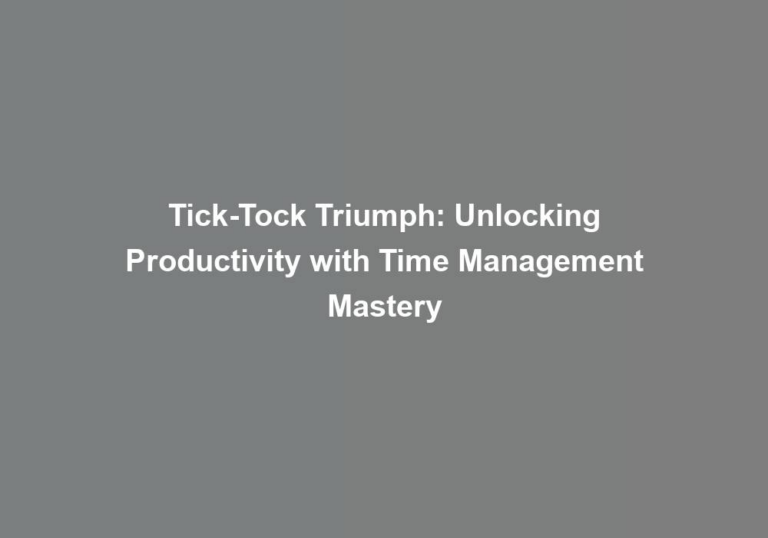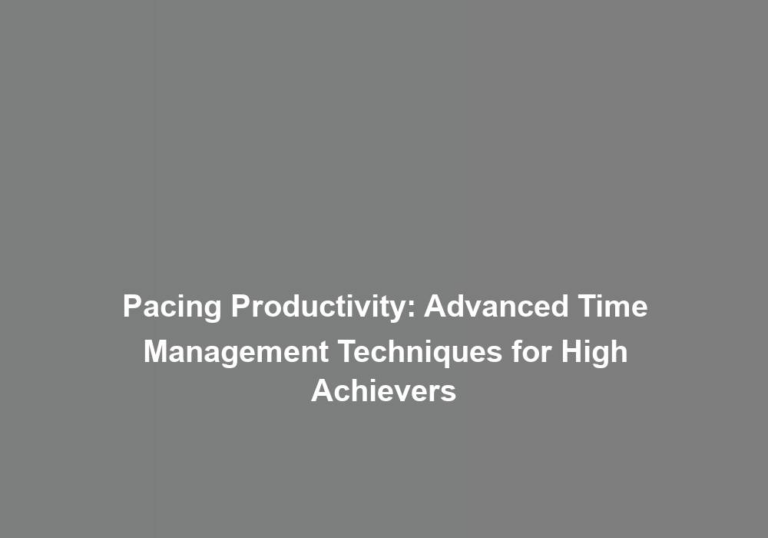Life’s Tempo: Crafting a Balanced Schedule with Time Management Expertise
Find yourself caught in the whirlwind of daily demands, yet yearning for a sense of balance and control in your schedule? Striking the right tempo in lifeG??s symphony of commitments can be a challenging feat, but fear not. By honing your time management skills and crafting a well-balanced schedule, you can achieve a harmonious blend of productivity and peace. This delicate dance of time and tasks requires a keen understanding of prioritization, focus, and efficient time allocation. Are you ready to take charge of your schedule and unlock the secrets to a more balanced and fulfilling life?
Understanding Time Management Principles
To effectively manage your time, it is imperative to understand the underlying principles that govern productivity and efficiency in tasks and activities. Setting boundaries is a fundamental aspect of time management. It involves clearly defining the limits of your availability for tasks, meetings, and commitments. By doing so, you can prioritize effectively and allocate the necessary time for each task, without overcommitting yourself. This helps in maintaining a balanced schedule and ensures that you are not spreading yourself too thin.
Minimizing distractions is another crucial principle in time management. Distractions can significantly derail your productivity and lead to a loss of valuable time. It is essential to identify the common distractions in your work environment and take proactive measures to mitigate their impact. This could involve setting specific times for checking emails or messages, finding a quiet workspace, or using tools to block out digital distractions. By minimizing these interruptions, you can create a focused and conducive environment for completing tasks efficiently.
Understanding these principles of setting boundaries and minimizing distractions is key to mastering time management. It empowers you to take control of your schedule, prioritize effectively, and maintain a productive workflow. By implementing these principles, you can create a balanced schedule that allows for both work and personal time, contributing to a sense of fulfillment and accomplishment.
Prioritizing Tasks Effectively
Prioritizing tasks effectively requires a strategic approach that considers the urgency, importance, and impact of each task on your overall goals and productivity. To effectively manage your tasks, consider the following strategies:
-
Urgency: Identify tasks that are time-sensitive and require immediate attention. These tasks are usually critical to meeting deadlines or resolving urgent issues. By addressing urgent tasks first, you can prevent them from escalating and causing unnecessary stress.
-
Importance: Evaluate the significance of each task in relation to your long-term goals and objectives. Important tasks contribute directly to your overall productivity and success. Focusing on important tasks ensures that you make progress towards your strategic priorities and avoid getting sidetracked by less critical activities.
-
Impact: Assess the potential impact of each task on your projects, responsibilities, and relationships. Some tasks may have a ripple effect, influencing multiple areas of your life or work. By recognizing the broader impact of a task, you can allocate your time and resources more effectively, leading to better outcomes.
Effective task management requires thoughtful time allocation strategies. By prioritizing tasks based on urgency, importance, and impact, you can optimize your productivity and achieve a better balance in your daily schedule. Remember, effective prioritization is not just about getting things done, but about getting the right things done.
Maximizing Productivity Through Focus
Maximizing your productivity through focused attention and deliberate time management techniques is essential for achieving your goals efficiently and effectively. Improving concentration is a key aspect of maximizing productivity. When you are able to concentrate deeply on a task, you are able to complete it more efficiently and with higher quality. To improve concentration, consider finding a quiet and comfortable space to work, minimizing distractions such as noise or clutter, and using techniques like the Pomodoro method, which involves working for a focused period of time followed by a short break.
Minimizing distractions is another crucial component of maximizing your productivity through focus. Distractions can come in many forms, from notifications on your phone to interruptions from colleagues or family members. ItG??s important to identify these distractions and take steps to minimize them. This might involve silencing your phone, setting specific times for checking emails or messages, or communicating with those around you about your dedicated work times.
Creating Efficient Time Blocks
Improving your productivity through focused attention and deliberate time management techniques naturally leads to the need for creating efficient time blocks in your schedule. To maximize your efficiency, consider the following time blocking techniques and scheduling strategies:
-
Prioritize Tasks: Identify the most important tasks and allocate specific time blocks to focus on them. This helps you ensure that crucial responsibilities receive the attention they deserve, leading to greater productivity and a sense of accomplishment.
-
Batch Similar Activities: Group similar tasks together within designated time blocks. For instance, if you have several meetings to attend, schedule them back to back to minimize context switching and optimize your focus during those interactions. This approach can also be applied to activities like responding to emails, making phone calls, or conducting research.
-
Include Breaks: Incorporate regular breaks into your time blocks to avoid burnout and maintain sustained productivity. Utilize short breaks to recharge and longer breaks for meals or physical activity, ensuring that you can return to your tasks with renewed energy and focus.
Maintaining Work-Life Balance
To maintain a healthy work-life balance, it is crucial to consciously allocate time for personal activities and relaxation, ensuring that work commitments do not overshadow other aspects of your life. Boundary setting and stress management are essential components in achieving this balance. By establishing clear boundaries between work and personal time, you can prevent work from encroaching on your personal life. This allows you to fully engage in activities outside of work, fostering a sense of fulfillment and reducing the risk of burnout.
| Boundary Setting | Stress Management |
|---|---|
| Clearly define work hours | Practice mindfulness |
| Communicate needs with colleagues | Engage in regular physical activity |
| Set limits on overtime work | Prioritize tasks effectively |
| Create designated relaxation spaces | Seek social support |
| Disconnect from work during personal time | Take regular breaks |
Setting boundaries not only helps in managing time effectively but also aids in maintaining a healthy work-life balance. Additionally, stress management techniques, such as mindfulness and regular physical activity, can significantly contribute to a balanced lifestyle. Prioritizing tasks effectively and seeking social support can also alleviate stress, allowing you to approach both work and personal activities with a clear and focused mind. By integrating these strategies into your daily routine, you can create a harmonious balance between your professional and personal life.
Conclusion
By mastering time management principles, you can prioritize tasks effectively and maximize productivity through focus. Creating efficient time blocks will help you maintain a balanced schedule and achieve work-life harmony. ItG??s all about finding the perfect tempo for your life, like a well-crafted symphony. So, take charge of your time and conduct your days with expertise, and watch as your life becomes a beautifully orchestrated masterpiece of productivity and fulfillment.







